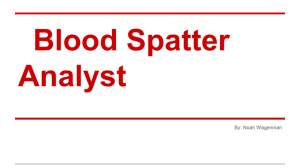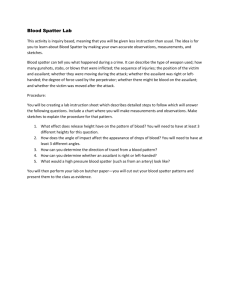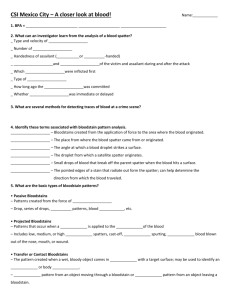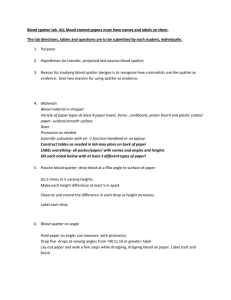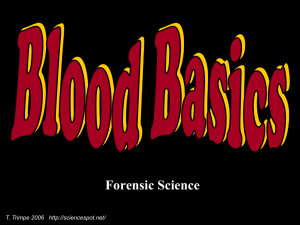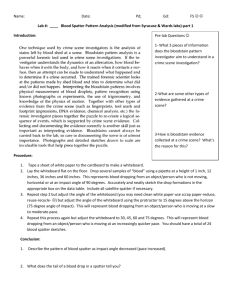Bloodstain Patterns
advertisement
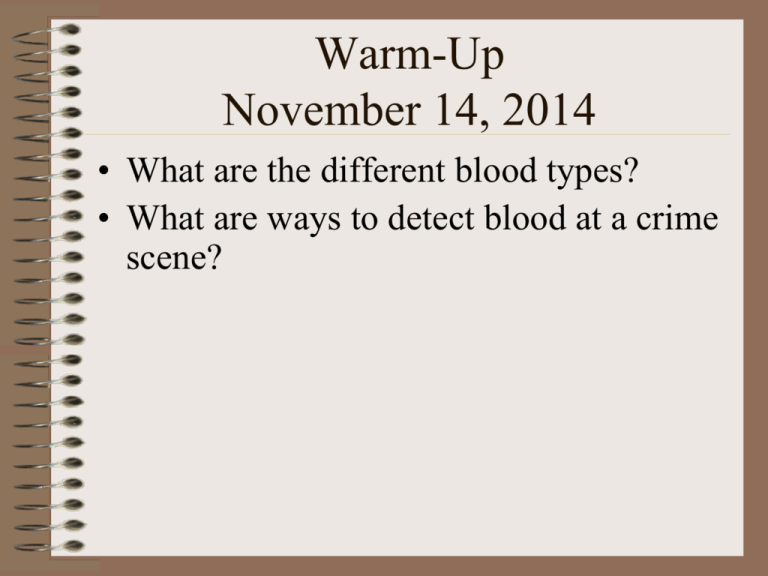
Warm-Up November 14, 2014 • What are the different blood types? • What are ways to detect blood at a crime scene? Objective • SWBAT analyze blood spatter. Agenda 1. 2. 3. 4. 5. Blood Typing Lab Grave Evidence Documentary Bloodstain Patterns Blood Spatter Lab Forensic Files Friday Forensic Science Blood Typing Lab Activity T. Trimpe 2006 http://sciencespot.net/ The Crime Report A small pool of blood and a weapon was found near a garbage dumpster. After examining the area, the CSI on the scene discovered a body in the garbage dumpster and identified him as Earnest “One-Eyed” Earl. Earl had a wound to his chest that will be analyzed by the medical examiner. The CSI tested blood samples from the blood pool and the weapon at the crime scene. It was determined that it was human blood, but he needs to know the blood type to help identify if it was from the victim or the person who murdered him. He has come up with three suspects that either knew the victim or were seen in the area before the body was discovered. He would like to question them further while he waits for DNA test results. Follow your teacher’s directions to complete the lab. Remember to be careful to prevent cross-contamination of the blood samples! Image: http://www.fbi.gov/publications/leb/2005/apr2005/apr2005leb_img_3.jpg Blood Typing Test We will be determining blood types using Anti-A serum, Anti-B serum, and Anti-RH serum. Use the chart to help you determine the blood type of each sample and its Rh factor (+ or -). Type Reaction w/ Anti-A Serum Reaction w/ Anti-B Serum A + - B - + AB + + O - - Clumping = + (Positive) No Clumping = - (Negative) Rh Serum - Clumping = Rh+ blood DIRECTIONS: Step 1: Label the three cups in your kit as Anti-A, Anti-B, and Anti-Rh. Step 2: Place 20 drops of the blood sample in each cup. Step 3: Place 10 drops of the anti-A serum in the A cup. Step 4: Place 10 drops of the anti-B serum in the B cup. Step 5: Place 10 drops of the anti-Rh serum in the Rh cup. Step 6: Use a clean toothpick for each sample and stir for 30 seconds. Step 7: Record your observations in the correct section on the back of the page and use the reaction chart at the top of this page to determine the blood type. Step 8: Complete the other sections using information from your classmates. Clumping = Positive Result Agglutination = Clumping = Positive Reaction Type Reaction w/ Anti-A Serum Reaction w/ Anti-B Serum A + - B - + AB + + O - - Rh Serum - Clumping = Rh+ blood A Rh B What is this person’s blood type? Answer: A+ Use + or – to show the test results for each sample and then determine the blood type. Results + = Clumping - = No clumping Conclusion What do your results show? What would you do next in the investigation? Grace Evidence Documentary 7. Where else was high velocity impact spatter found and what does this indicate? 8. What was wrong with the wound track? 9. What was Scher’s motive? 10. How did Scher change his story when he saw the forensic evidence? 11. Why was Dr. Scher’s conviction overturned? Forensic Science Lab Activity Warning: Some material in this presentation and related videos may be too graphic for some people. T. Trimpe 2006 http://sciencespot.net/ What does the abbreviation BPA represent? Bloodstain Pattern Analysis What can an investigator learn from the analysis of a blood spatter? Type and velocity of weapon Number of blows Handedness of assailant (right or left-handed) Position and movements of the victim and assailant during and after the attack Which wounds were inflicted first Type of injuries How long ago the crime was committed Whether death was immediate or delayed Source: http://science.howstuffworks.com/bloodstain-pattern-analysis1.htm http://www.crimescenetwo.com/img/popup/book2p2.jpg How is blood evidence detected at a crime scene? Light Source Investigators will first examine the crime scene to look for areas that may contain blood. They may use a high-intensity light or UV lights to help them find traces of blood as well as other bodily fluids that are not visible under normal lighting conditions. Blood Reagent Tests These tests, referred to as presumptive tests, are used to detect blood at crime scenes based upon the properties of hemoglobin in the blood. Further tests at the crime lab can determine if it is human blood or not. Kastle-Meyer Test Video Examples: • Phenolphthalein is a chemical that is still utilized today and is usually referred to as the Kastle-Meyer test and produces a pink color when it reacts with hemoglobin. •HemaStix is a strip that has been coated with tetramethylbenzidine (TMB) and will produce a green or bluegreen color with the presence of hemoglobin. HemaStix Luminol This chemical is used by crime scene investigators to locate traces of blood, even if it has been cleaned or removed. Investigators spray a luminol solution is throughout the area under investigation and look for reactions with the iron present in blood, which causes a blue luminescence. One problem is that other substances also react, such as some metals, paints, cleaning products, and plant materials. Another problem is that the chemical reaction can destroy other evidence in the crime scene. Fluorescein This chemical is also capable of detecting latent or old blood, similar to luminol. It is ideal for fine stains or smears found throughout a crime scene. After the solution has been sprayed onto the substance or area suspected to contain blood, a UV light and goggles are used to detect any illuminated areas, which appear greenish-white if blood is present. It may also react to many of the same things as luminol (copper and bleach). Luminol Reaction Fluorescein Reaction in UV Light LCV or Leuco Crystal Violet, is one type of chemical process that is used for blood enhancement. Using this test helps to make the blood evidence more visible so it can be photographed and analyzed. Bloodstain Pattern Analysis Terms • Spatter – Bloodstains created from the application of force to the area where the blood originated. • Origin/Source – The place from where the blood spatter came from or originated. • Angle of Impact – The angle at which a blood droplet strikes a surface. • Parent Drop – The droplet from which a satellite spatter originates. • Satellite Spatters – Small drops of blood that break of from the parent spatter when the blood droplet hits a surface. • Spines – The pointed edges of a stain that radiate out from the spatter; can help determine the direction from which the blood traveled. Satellite Spatters Spines Parent Drop Types of Bloodstain Patterns Blood Spatter Movie • Passive Bloodstains – Patterns created from the force of gravity – Drop, series of drops, flow patterns, blood pools, etc. • Projected Bloodstains – Patterns that occur when a force is applied to the source of the blood – Includes low, medium, or high impact spatters, castoff, arterial spurting, expiratory blood blown out of the nose, mouth, or wound. • Transfer or Contact Bloodstains – These patterns are created when a wet, bloody object comes in contact with a target surface; may be used to identify an object or body part. – A wipe pattern is created from an object moving through a bloodstain, while a swipe pattern is created from an object leaving a bloodstain. Images from http://www.bloodspatter.com/BPATutorial.htm Blood Spatters May Reveal: • • • • • • • Origin(s) of bloodstain Distance of bloodstain from target Direction from which blood impacted Speed with which blood left its source Position of victim & assailant Movement of victim & assailant Number of blows, shots, etc. Liquid Blood • Behaves as a projectile in motion – Gravity as only force – falls vertically – Gravity with another force – falls vertically and horizontally at the same time Surface Tension • Resistant to penetration & separation • Acts to reduce surface area • A sphere offers the smallest surface area to volume ratio so free falling blood drops are spherical (not “teardrop”) on impact Dripping Blood Gravity is the only force acting Blood drop grows until Wt (G) > S.T. Single drop breaks free (teardrop shape) Surface tension pulls in vertically And horizontally Shape settles into sphere (0.05 ml volume) Does not break up until impact Factors Affecting Drop Size Rapid bleeding gives Standard drop size 50ul (0.05ml) slightly larger drop Shaking/movement casts off smaller drops Breaks surface tension . . . Shape & Size of Bloodspot • Depends mostly on nature of target surface – Texture (rough or smooth) – Porous or non porous – Angle of impact • Size is also related to distance fallen – Given a standard 50 ul drop of blood • There is little change in spot diameter beyond a fall distance of 4 ft (1.2m) Drop Size vs. Height Fallen Single drops of blood falling from fingertip onto smooth cardboard from various heights. No change in diameter beyond 7 ft. Adapted from Introduction to Forensic Sciences, W. Eckert, CRC, 1997 A blood droplet falling from various heights (ft) onto various surfaces (90 degrees) 1.5 1.5 3 3 Height/Surface 7 7 10 10 smooth floor paper towel fabric Angle of Impact 90 80 70 60 50 40 30 20 Elongated shape; more dense at lower edge 10 Adapted from Introduction to Forensic Sciences, W. Eckert, CRC, 1997 David Sadler: Wave Cast-off Angles < 20 degrees to surface Tail of elongated stain points in direction of travel . Tail of wave cast-off points back to parent drop Parent drop wave cast-off 5 ml of blood squirted from a syringe from a height of 1m Point of Convergence Direction and Origin • Point of Convergence – Two dimensional – Shows direction • Point of Origin – Three dimensional – Shows direction and height Point of Convergence Height above point of convergence Point of Origin Origin length width Angle of impact = arc sin W/L (Parent Drop) 85 60 45 Distance from point of convergence 30 Tracing Origin of Bloodspots • Point of convergence method – 2 dimensional; shows direction • Point of origin method – 3 dimensional; to include height • In practice: – use of string & protractor at scene – use of computer at laboratory Blood Spatter Velocity • Low velocity (5 f/s, 1.5 m/s) – Free-falling drops, cast off from weapon • Medium velocity (25 - 100 f/s, 7.5 - 30 m/s) – Baseball bat blows • High velocity (>100 f/s, >30 m/s) – Gunshot, machinery Low Velocity Blood Spatter • Blood source subjected to LV impact – < 5 f/s (1.5 m/s) • Spot diameter: mostly 4 - 8 mm – some smaller, some larger • • • • • Free-falling drops (gravity only) Cast off from fist, weapon, etc. Dripping (blood droplets into themselves) Splashing (stepping, throwing, etc.) Arterial spurting Cast-off from Weapon • First blow causes bleeding • Subsequent blows contaminate weapon with blood • Blood is cast-off at a tangent to arc of upswing or backswing (90 degrees) • Pattern & intensity depends on: – type of weapon – amount of blood adhering to weapon – length of arc, swing Downswing of Hammer Dripping Pattern • • • • Free-falling drops dripping into wet blood Falling from a stationary object Large irregular central stain Small round & oval satellite stains . .. .. . . . . . . .. . .. . . Blood dripping into itself from height of 1 m (8 drops) Notice Irregular Central Stain Drip 1: Blood dripping into itself from height of 1 m (8 drops) Closer View Showing Round and Oval Satellite Stains Drip 2 Splash Pattern • Volume > 1 ml – Subjected to LV impact – Thrown – Tipped • Large central irregular area surrounded by elongated peripheral spatter pattern Splash 1 5 ml blood squirted from a syringe from a height of 1m 5 ml blood squirted from a syringe from a height of 1 m (Closer View of Central Stain) Splash 2 5 ml blood squirted from a syringe from a height of 1 m (Closer View of Peripheral Stains) Direction? Splash 3 Splashing on a vertical surface 10 ml blood thrown 1 m onto a vertical surface 6” ruler Blood pool (10 drops) before stamping Stamp 1 Blood pool (10 drops) after stamping with shoe Stamp 2 Arterial Spurt Pattern • Blood exiting body under arterial pressure (120 mm Hg); corresponds to heart beating • Large stains with downward flow on vertical surfaces; air bubbles present if lung was punctured • Creates a wave-like appearance Arterial Spurt Pattern Medium Velocity Blood Spatter • Blood source subjected to MV impact – (25 - 100 f/s, 7.5 - 30 m/s) • Spot diameter: mostly 1 - 4 mm • Blows with weapon (baseball bat, etc) Cast-off (LV) & Medium Velocity Spatter Cast-off & Medium Velocity Spatter (Close-up) High Velocity Blood Spatter • Blood source subjected to HV impact – > 100 f/s, 30 m/s • • • • Fine mist: spot size < 0.1 mm Small mass limits spread to 1 m Some larger droplets reach further Gunshot – back-spatter from entry wound – forward spatter from exit wound • High speed machinery Gunshot: Back & Forward Spatter Bloodstained foam held just above target surface. Bullet passing L to R just above sheet bullet exits foam Bullet enters foam bullet Back spatter on entry Forward spatter on exit Gunshot Back Spatter • • • • Arises from entrance wound Passes back towards weapon & shooter Seen only at close range of fire Seen on: – inside of barrel – exterior of weapon – hand, arm, chest of shooter Back spatter on steadying hand Gunshot Forward Spatter • • • • • Arises from exit wound Passes forward in same direction as shot More copious than back-spatter Can be seen at any range of fire Seen on nearby surfaces, objects, persons – especially on wall behind victim Forward spatter (5 ms after bullet impacted at 1000 f/s) bullet blood soaked target Forward spatter on a target (15cm from exit point) due to a HV impact (bullet) 6” ruler Forward Spatter (closer view to show misting) Forward Spatter (closest view) Droplet Size 0.1mm 5 mm Other Patterns • Bloodstain patterns that have been altered – Altered by objects, gravity, others • Include: – – – – Wipe Patterns Swipe Patterns Transfer Patterns Flow Patterns Wipe and Swipe Patterns • Wipe – Object moves through a wet bloodstain – Removes and/or alters bloodstain appearance – Does not require a swipe pattern be present • Swipe – Transfer of blood to an unstained surface – Direction may be determined by feathered edge – A wipe pattern must also be present Transfer Patterns • Wet, bloodied object contacts a secondary surface • Transfer from: – hand, fingers – shoes, weapon – hair • Transfer to: – walls, ceilings – clothing, bedding • Produces mirror-image of bloodied object Transfer from hair Flow Patterns • Blood flows horizontally & vertically • Altered by contours, obstacles • Often ends in pool Flow Pattern Showing Pooling of Blood Homework Chapter 8 Review, #1-25 due Monday Forensic Files Friday
